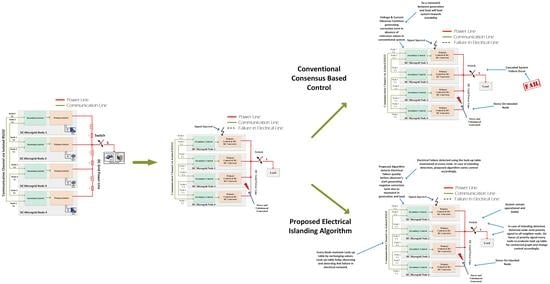RES Based Islanded DC Microgrid with Enhanced Electrical Network Islanding Detection
Abstract
:1. Introduction
- Every node can inject disturbance to check the electrical network connectivity. After one node injects disturbance, then other nodes receive disturbance signal, and on that basis detection of islanding occurs.
- The proposed control has the plug and play capabilities in which DC MG does not require prior information of the agent nodes.
- Converters can communicate with its neighboring nodes using the sparse communication network spanned across the MG.
- Electrical network islanding is detected using the existing communication network without adding any more complexity.
2. Detection and Impact of Islanding
3. Motivation of Electrical Islanding Detection in DC Microgrid
3.1. Electrical Islanding Motivation of DC System
3.1.1. DC Utility Load
3.1.2. RE Based Sources
3.1.3. Storage Sources
3.2. Islanding Detection Motivation
3.2.1. Islanded Operation
3.2.2. Islanded Phenomenon
- Safety Concern
- Consumer’s Appliances Damages
- Damage to Inverters
- Restoration Delay
4. Detection Methods (IDMs)
4.1. Detection Using Passive Scheme
4.2. Detection Using Active Scheme
4.3. Detection Using Remote Method
4.4. DC Network
5. Electrical Network Islanding Detection Algorithm
5.1. Representation of the Network
5.2. Proposed Islanding Detection
5.3. DC MG System Modeling
6. Case Study
7. Comparison Study with Existing Control Techniques
8. Conclusions
Author Contributions
Funding
Institutional Review Board Statement
Informed Consent Statement
Data Availability Statement
Conflicts of Interest
References
- Merino, J.; Mendoza-Araya, P.; Venkataramanan, G.; Baysal, M. Islanding Detection in Microgrids Using Harmonic Signatures. IEEE Trans. Power Deliv. 2014, 30, 2102–2109. [Google Scholar] [CrossRef] [Green Version]
- De Mango, F.; Liserre, M.; Dell’Aquila, A.; Pigazo, A. Overview of Anti-Islanding Algorithms for PV Systems. Part I: Passive Methods. In Proceedings of the EPE-PEMC 2006: 12th International Power Electronics and Motion Control Conference, Portoroz, Slovenia, 30 August–1 September 2006. [Google Scholar]
- Wang, D.; Emhemed, A.; Burt, G. A Novel Protection Scheme for an LVDC Distribution Network with Reduced Fault Levels. In Proceedings of the 2017 IEEE 2nd International Conference on Direct Current Microgrids (ICDCM 2017), Nuremburg, Germany, 27–29 June 2017; pp. 69–75. [Google Scholar]
- Saleh, K.A.; Hooshyar, A.; El-Saadany, E.F. Ultra-High-Speed Traveling-Wave-Based Protection Scheme for Medium-Voltage DC Microgrids. IEEE Trans. Smart Grid 2017, 10, 1440–1451. [Google Scholar] [CrossRef]
- Makkieh, A.; Florida-James, A.; Tzelepis, D.; Emhemed, A.; Burt, G.; Strachan, S.; Junyent-Ferre, A. Assessment of Passive Islanding Detection Methods for DC Microgrids. In Proceedings of the 15th IET International Conference on AC and DC Power Transmission (ACDC 2019), Coventry, UK, 5–7 February 2019; pp. 1–6. [Google Scholar]
- De Mango, F.; Liserre, M.; Dell’Aquila, A.; Pigazo, A. Overview of Anti-Islanding Algorithms for PV Systems. Part II: Active Methods. In Proceedings of the EPE-PEMC 2006: 12th International Power Electronics and Motion Control Conference, Portoroz, Slovenia, 30 August–1 September 2006; pp. 1884–1889. [Google Scholar]
- Sultana, B.; Mustafa, M.; Sultana, U.; Bhatti, A.R. Review on Reliability Improvement and Power Loss Reduction in Distribution System via Network Reconfiguration. Renew. Sustain. Energy Rev. 2016, 66, 297–310. [Google Scholar] [CrossRef]
- Emhemed, A.A.S.; Fong, K.; Fletcher, S.; Burt, G. Validation of Fast and Selective Protection Scheme for an LVDC Distribution Network. IEEE Trans. Power Deliv. 2016, 32, 1432–1440. [Google Scholar] [CrossRef] [Green Version]
- Mirsaeidi, S.; Dong, X.; Shi, S.; Tzelepis, D. Challenges, Advances and Future Directions in Protection of Hybrid AC/DC Microgrids. IET Renew. Power Gener. 2017, 11, 1495–1502. [Google Scholar] [CrossRef] [Green Version]
- Khadem, S.K.; Basu, M.; Conlon, M.F. Intelligent Islanding and Seamless Reconnection Technique for Microgrid With UPQC. IEEE J. Emerg. Sel. Top. Power Electron. 2014, 3, 483–492. [Google Scholar] [CrossRef]
- Son, T.T.; Fujita, G. Islanding Detection in DC Network. In Proceedings of the 52nd International Universities Power Engineering Conference (UPEC), Heraklion, Greece, 29 August–1 September 2017. [Google Scholar]
- Paz, F.; Ordonez, M. An Impedance-Based Islanding Detection Method for DC Grids. In Proceedings of the 2018 9th IEEE International Symposium on Power Electronics for Distributed Generation Systems (PEDG), Charlotte, NC, USA, 25–28 June 2018; IEEE: Piscataway, NJ, USA, 2018; pp. 1–7. [Google Scholar]
- Seo, G.; Baek, J.; Choi, K.; Bae, H.; Cho, B. Modeling and Analysis of DC Distribution Systems. In Proceedings of the 8th International Conference on Power Electronics—ECCE Asia, Jeju, Korea, 30 May–3 June 2011; IEEE: Piscataway, NJ, USA, 2011; pp. 223–227. [Google Scholar]
- Bansal, Y.; Sodhi, R. Microgrid Fault Detection Methods: Reviews, Issues and Future Trends. In Proceedings of the IEEE Innovative Smart Grid Technologies—Asia (ISGT Asia), Singapore, 22–25 May 2018; pp. 401–406. [Google Scholar] [CrossRef]
- Sannino, A.; Postiglione, G.; Bollen, M. Feasibility of a DC Network for Commercial Facilities. In Proceedings of the Conference Record of the 2002 IEEE Industry Applications Conference. 37th IAS Annual Meeting (Cat. No.02CH37344), Pittsburgh, PA, USA, 13–18 October 2002. [Google Scholar] [CrossRef]
- Ghareeb, A.T.; Mohamed, A.A.; Mohammed, O.A. DC Microgrids and Distribution Systems: An Overview. In Proceedings of the IEEE Power and Energy Society General Meeting, Vancouver, BC, Canada, 21–25 July 2013. [Google Scholar]
- Cintuglu, M.H.; Mohammed, O.A. Islanding Detection in Microgrids. In Proceedings of the 2013 IEEE Power & Energy Society General Meeting, Vancouver, BC, Canada, 21–25 July 2013; pp. 1–5. [Google Scholar] [CrossRef]
- Mohamad, A.M.I.; Mohamed, Y.A.-R.I. Assessment and Performance Comparison of Positive Feedback Islanding Detection Methods in DC Distribution Systems. IEEE Trans. Power Electron. 2016, 32, 6577–6594. [Google Scholar] [CrossRef]
- Papadimitriou, C.N.; Kleftakis, V.A.; Hatziargyriou, N.D. A Novel Method for Islanding Detection in DC Networks. IEEE Trans. Sustain. Energy 2016, 8, 441–448. [Google Scholar] [CrossRef]
- Seo, G.-S.; Lee, K.-C.; Cho, B.-H. A New DC Anti-Islanding Technique of Electrolytic Capacitor-Less Photovoltaic Interface in DC Distribution Systems. IEEE Trans. Power Electron. 2012, 28, 1632–1641. [Google Scholar] [CrossRef]
- Vahedi, H.; Noroozian, R.; Jalilvand, A.; Gharehpetian, G.B. A New Method for Islanding Detection of Inverter-Based Distributed Generation Using DC-Link Voltage Control. IEEE Trans. Power Deliv. 2011, 26, 1176–1186. [Google Scholar] [CrossRef]
- Emhemed, A.; Burt, G. The Effectiveness of Using IEC61660 for Characterising Short-Circuit Currents of Future Low Voltage DC Distribution Networks. In Proceedings of the 22nd International Conference and Exhibition on Electricity Distribution (CIRED 2013), Stockholm, Sweden, 10–13 June 2013; Volume 5, pp. 3–6. [Google Scholar]
- Haider, R.; Kim, C.H.; Ghanbari, T.; Bukhari, S.B.A.; Zaman, M.S.U.; Baloch, S.; Oh, Y.S. Passive Islanding Detection Scheme Based on Autocorrelation Function of Modal Current Envelope for Photovoltaic Units. IET Gener. Transm. Distrib. 2017, 12, 726–736. [Google Scholar] [CrossRef]
- Do, H.T.; Zhang, X.; Nguyen, N.V.; Li, S.S.; Chu, T.T.-T. Passive Islanding Detection Method Using Wavelet Packet Transform in Grid Connected Photovoltaic Systems. IEEE Trans. Power Electron. 2015, 31, 1. [Google Scholar] [CrossRef]
- Link, C.; Zeineldin, H.H.; Kirtley, J.L. Performance of the OVP/UVP and OFP/UFP Method with Voltage and Frequency Dependent Loads. IEEE Trans. Power Deliv. 2013, 24, 772–778. [Google Scholar]
- Dou, C.X.; Liu, B. Multi-agent based hierarchical hybrid control for smart microgrid. IEEE Trans. Smart Grid 2013, 4, 771–778. [Google Scholar] [CrossRef]
- Gill, S.; Dolan, M.; Emhemed, A.; Kockar, I.; Barnacle, M.; Ault, G.; Mathieson, C. Increasing Renewable Penetration on Islanded Networks through Active Network Management: A Case Study from Shetland. IET Renew. Power Gener. 2015, 9, 453–465. [Google Scholar] [CrossRef] [Green Version]
- Tzelepis, D.; Dysko, A.; Booth, C. Performance of Loss-Of-Mains Detection in Multi-Generator Power Islands. In Proceedings of the 13th International Conference on Development in Power System Protection 2016 (DPSP), Edinburgh, UK, 7–10 March 2016; pp. 1–6. [Google Scholar]
- Mohamad, A.M.I.; Mohamed, Y.A.-R.I. Analysis and Mitigation of Interaction Dynamics in Active DC Distribution Systems with Positive Feedback Islanding Detection Schemes. IEEE Trans. Power Electron. 2017, 33, 2751–2773. [Google Scholar] [CrossRef]
- Kleftakis, V.A.; Lagos, D.T.; Papadimitriou, C.N.; Hatziargyriou, N.D. Seamless Transition between Interconnected and Islanded Operation of DC Microgrids. IEEE Trans. Smart Grid 2017, 10, 248–256. [Google Scholar] [CrossRef]
- Voglitsis, D.; Papanikolaou, N.; Kyritsis, A. Incorporation of Harmonic Injection in an Interleaved Flyback Inverter for the Implementation of an Active Anti-Islanding Technique. IEEE Trans. Power Electron. 2016, 32, 8526–8543. [Google Scholar] [CrossRef]
- Kashyap, G.; Ambika, G. Link Deletion in Directed Complex Networks. Phys. A Stat. Mech. Its Appl. 2018, 514, 631–643. [Google Scholar] [CrossRef] [Green Version]
- Park, J.-D.; Candelaria, J.; Ma, L.; Dunn, K. DC Ring-Bus Microgrid Fault Protection and Identification of Fault Location. IEEE Trans. Power Deliv. 2013, 28, 2574–2584. [Google Scholar] [CrossRef]
- Funabashi, T.; Member, S.; Koyanagi, K.; Yokoyama, R. A Review of Islanding Detection Methods for Distributed Resources. In Proceedings of the 2003 IEEE Bologna PowerTech Conference Proceeding, Bologna, Italy, 23–26 June 2003; p. 6. [Google Scholar]
- Starke, M.; Member, S.; Tolbert, L.M.; Member, S. AC vs. DC Distribution: A Loss Comparison. In Proceedings of the 2008 IEEE/PES Transmission and Distribution Conference and Exposition, Chicago, IL, USA, 21–24 April 2008. [Google Scholar]
- Syamsuddin, S.; Rahim, N.; Krismadinata; Selvaraj, J. Implementation of TMS320F2812 in Islanding Detection for Photovoltaic Grid Connected Inverter. In Proceedings of the 2009 International Conference for Technical Postgraduates (TECHPOS), Kuala Lumpur, Malaysia, 14–15 December 2009; pp. 1–5. [Google Scholar] [CrossRef]
- Ganivada, P.K.; Jena, P. Passive Islanding Detection Techniques Using Synchrophasors for Inverter Based Distributed Generators. In Proceedings of the 2019 IEEE PES GTD Grand International Conference and Exposition Asia (GTD Asia), Bangkok, Thailand, 20–23 March 2019; IEEE: Piscataway, NJ, USA, 2019; pp. 747–751. [Google Scholar]
- Zhou, B.; Cao, C.; Li, C.; Cao, Y.; Chen, C.; Li, Y.; Zeng, L. Hybrid Islanding Detection Method Based on Decision Tree and Positive Feedback for Distributed Generations. IET Gener. Transm. Distrib. 2015, 9, 1819–1825. [Google Scholar] [CrossRef]
- Habibi, D.; Phung, Q.V. Graph Theory for Survivability Design in Communication Networks. In New Frontiers in Graph Theory; Intech Limied: London, UK, 2012; pp. 421–434. ISBN 9789535101154. [Google Scholar]
- Lewis, F.L.; Zhang, H.; Hengster-Movric, K.; Das, A. Cooperative Control of Multi-Agent Systems, 1st ed.; Springer: London, UK, 2014; ISBN 978-1-4471-5573-7. [Google Scholar]
- Lee, K.K.-C.; Chen, C.-E. An Eigen-Based Approach for Enhancing Matrix Inversion Approximation in Massive MIMO Systems. IEEE Trans. Veh. Technol. 2016, 66, 5480–5484. [Google Scholar] [CrossRef]
- Johnson, C.C.; Demetriades, A.; Locutura, J.; Ottesen, R.T. Mapping the Chemical Environment of Urban Areas; John Wiley & Sons, Ltd.: Hoboken, NJ, USA, 2011; ISBN 9788578110796. [Google Scholar]
- Nasirian, V.; Moayedi, S.; Davoudi, A.; Lewis, F.L. Distributed Cooperative Control of DC Microgrids. IEEE Trans. Power Electron. 2014, 30, 2288–2303. [Google Scholar] [CrossRef]
- Mesbahi, M.; Egerstedt, M. Graph Theoretic Methods in Multiagent Networks Book; Princeton University Press: Princeton, NJ, USA, 2010. [Google Scholar]
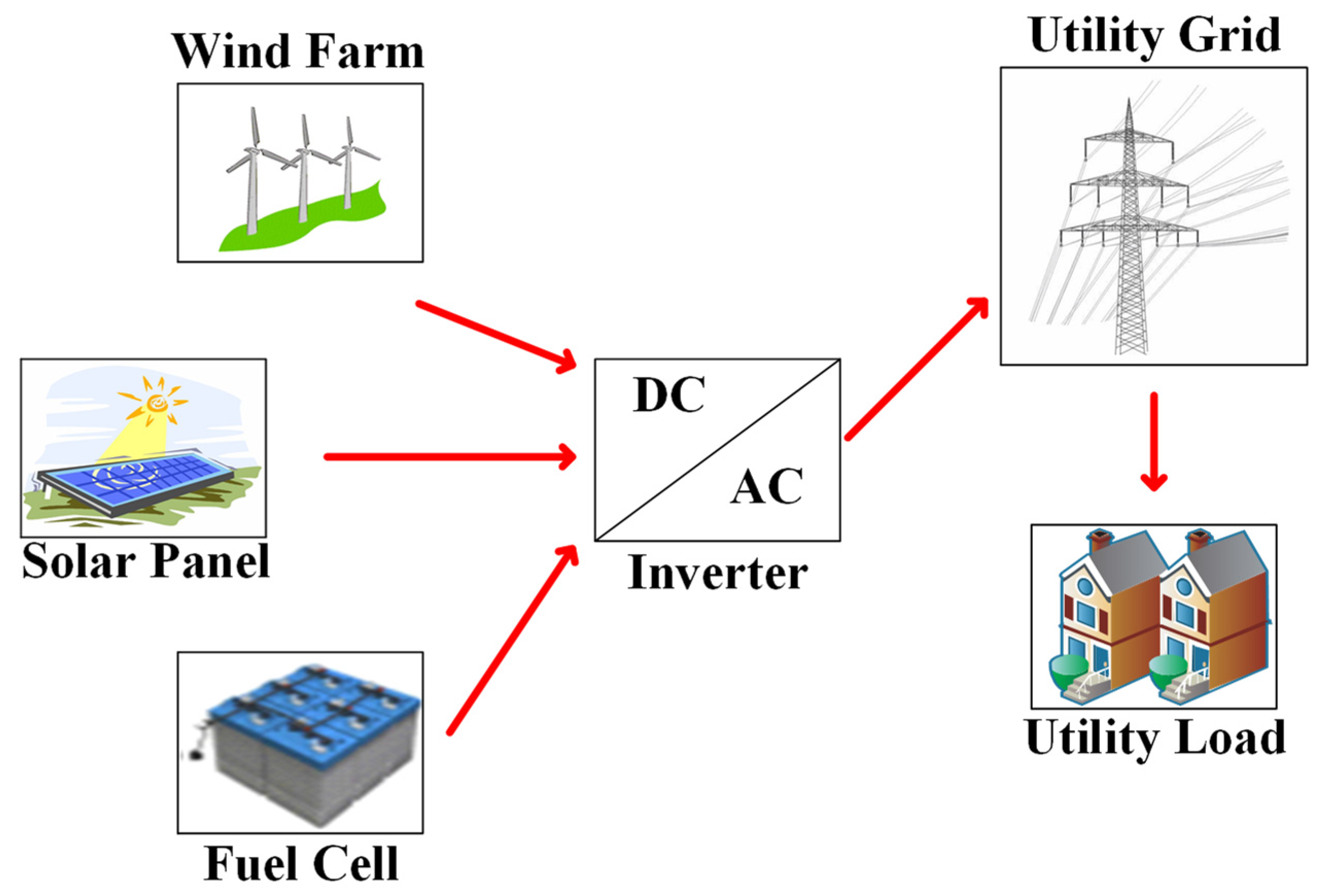
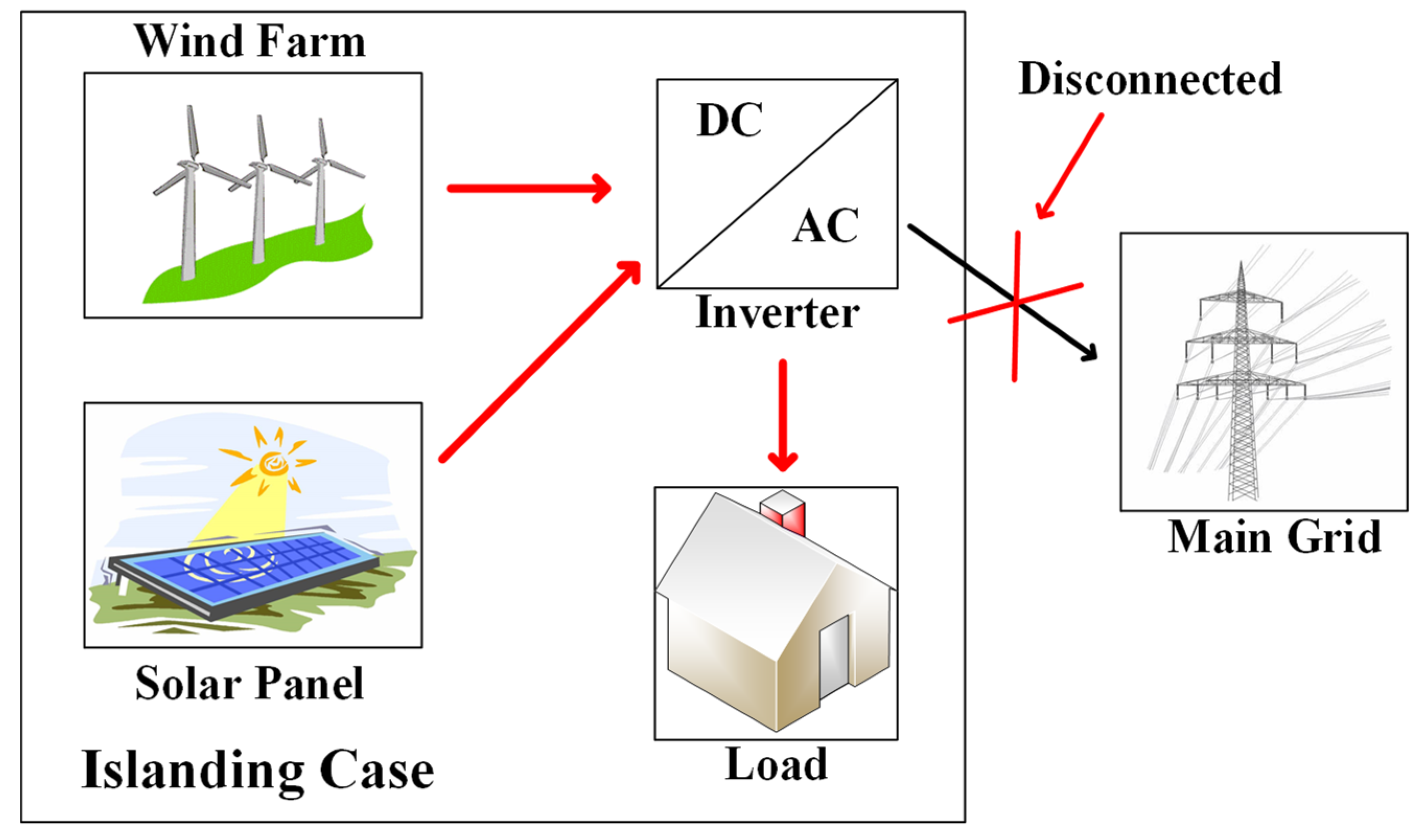
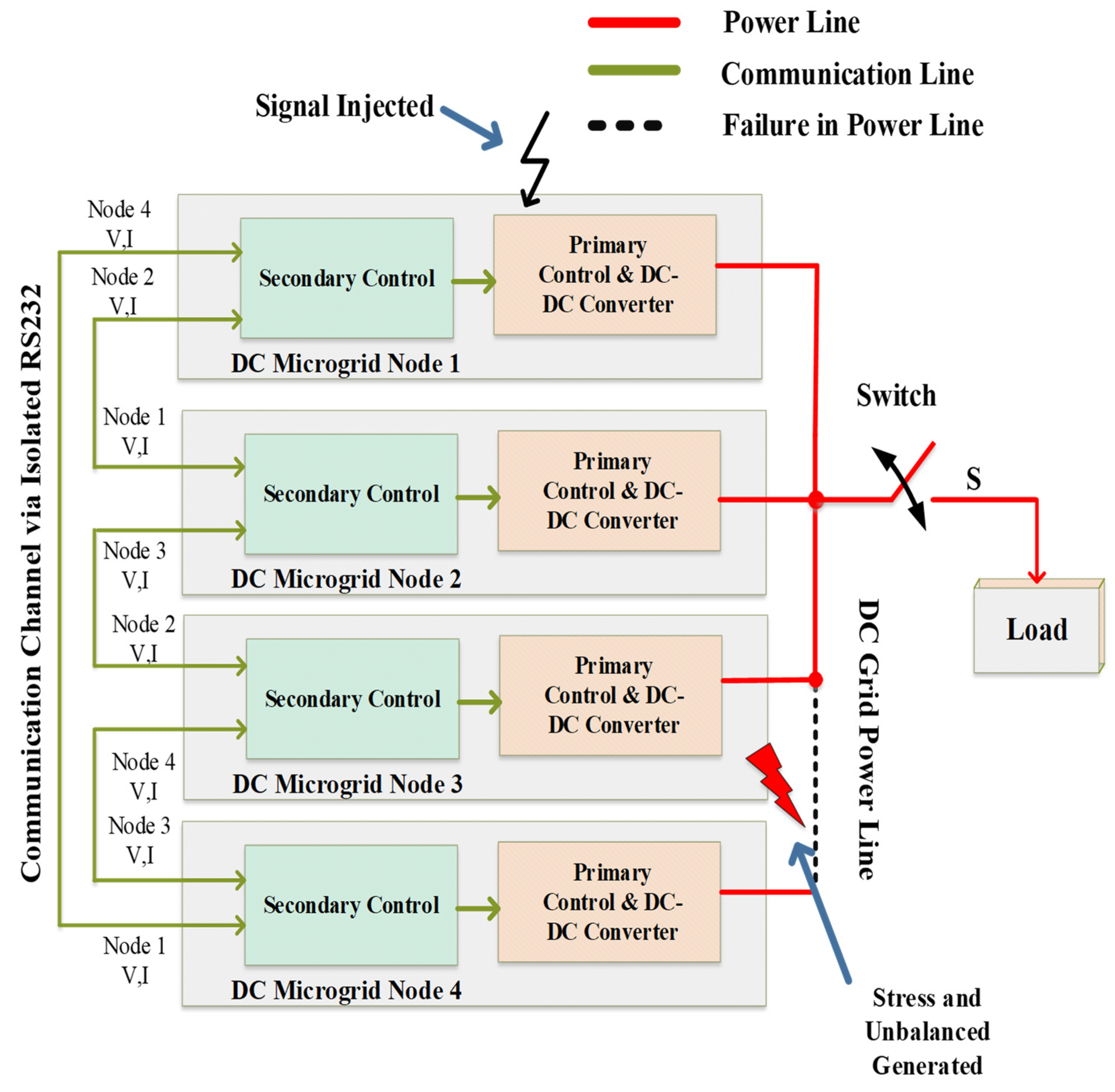
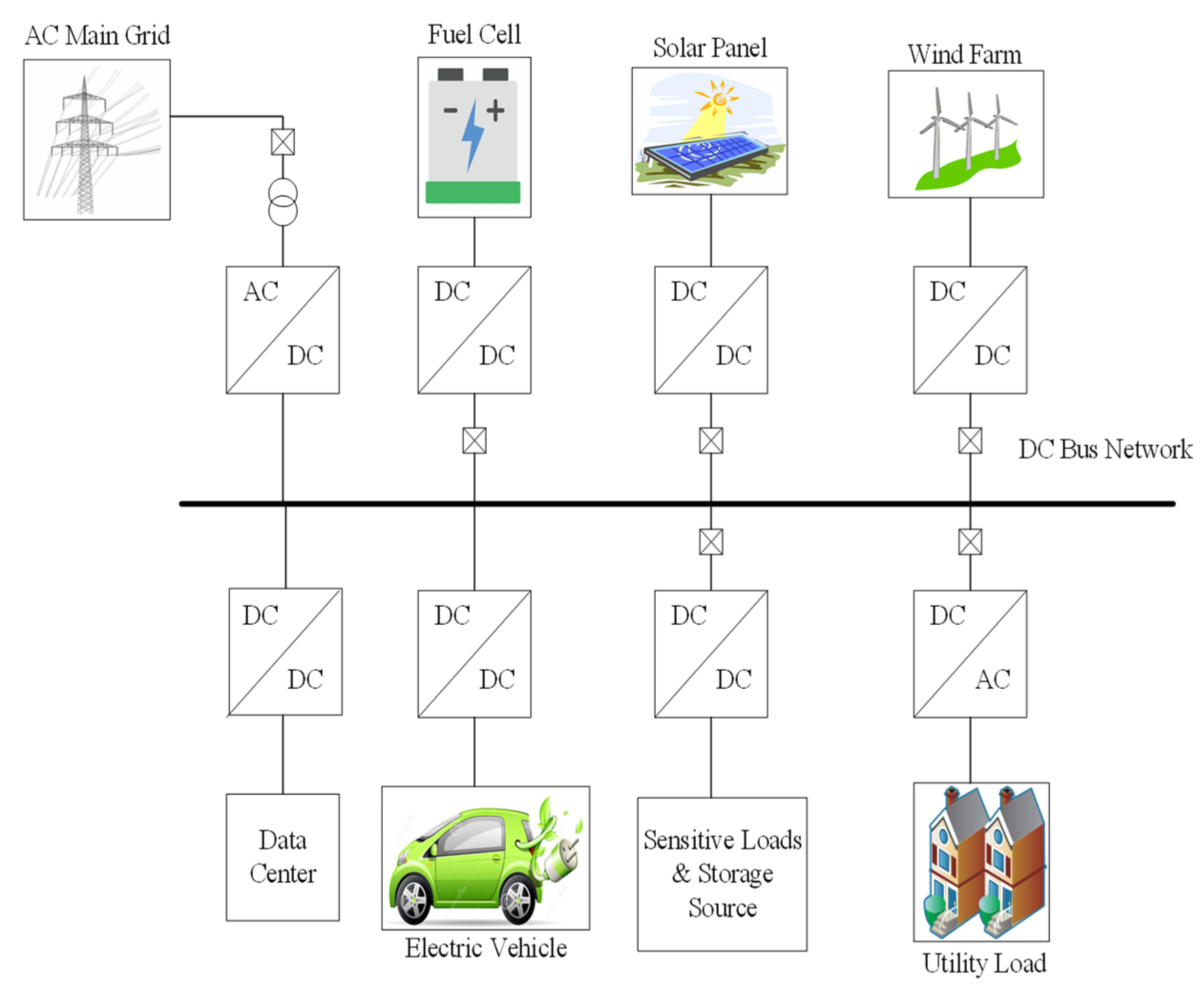
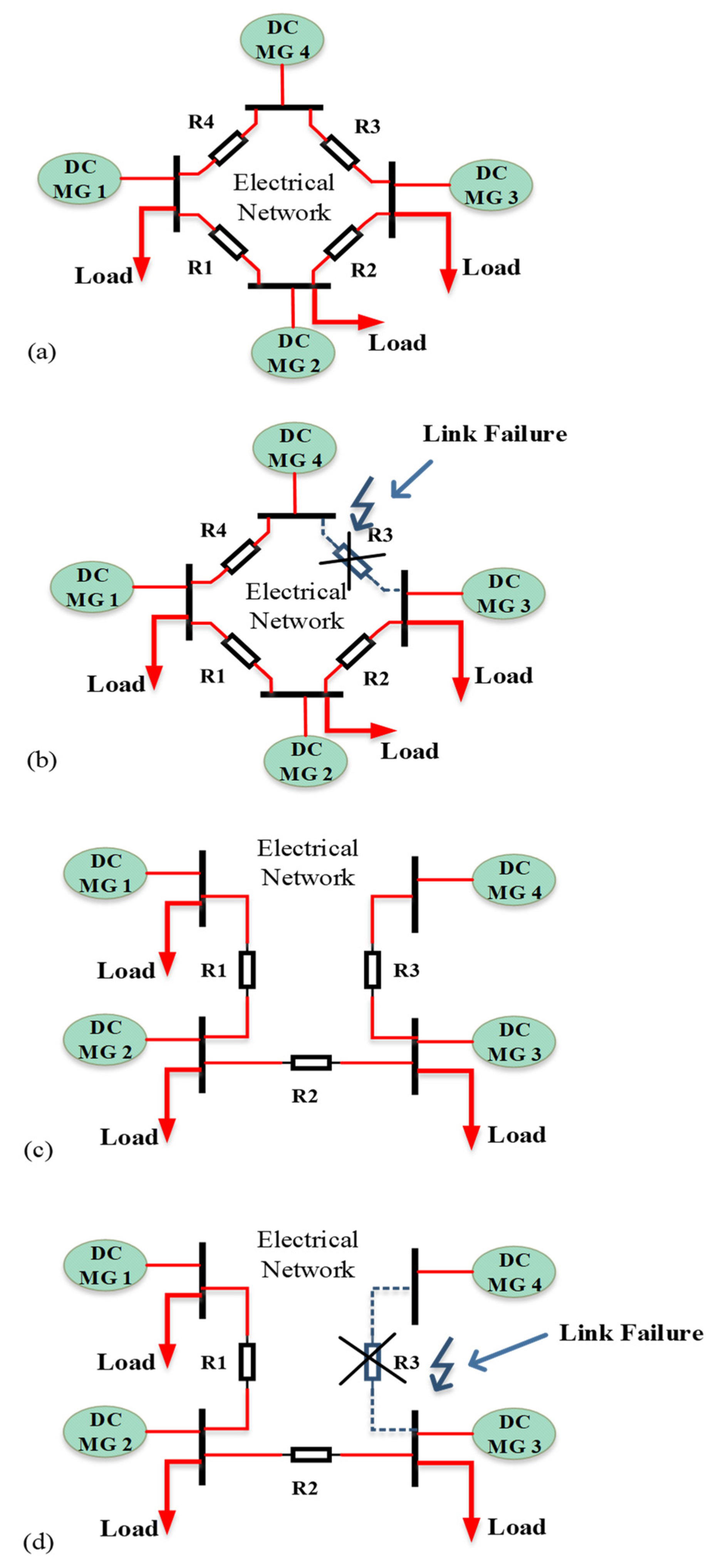
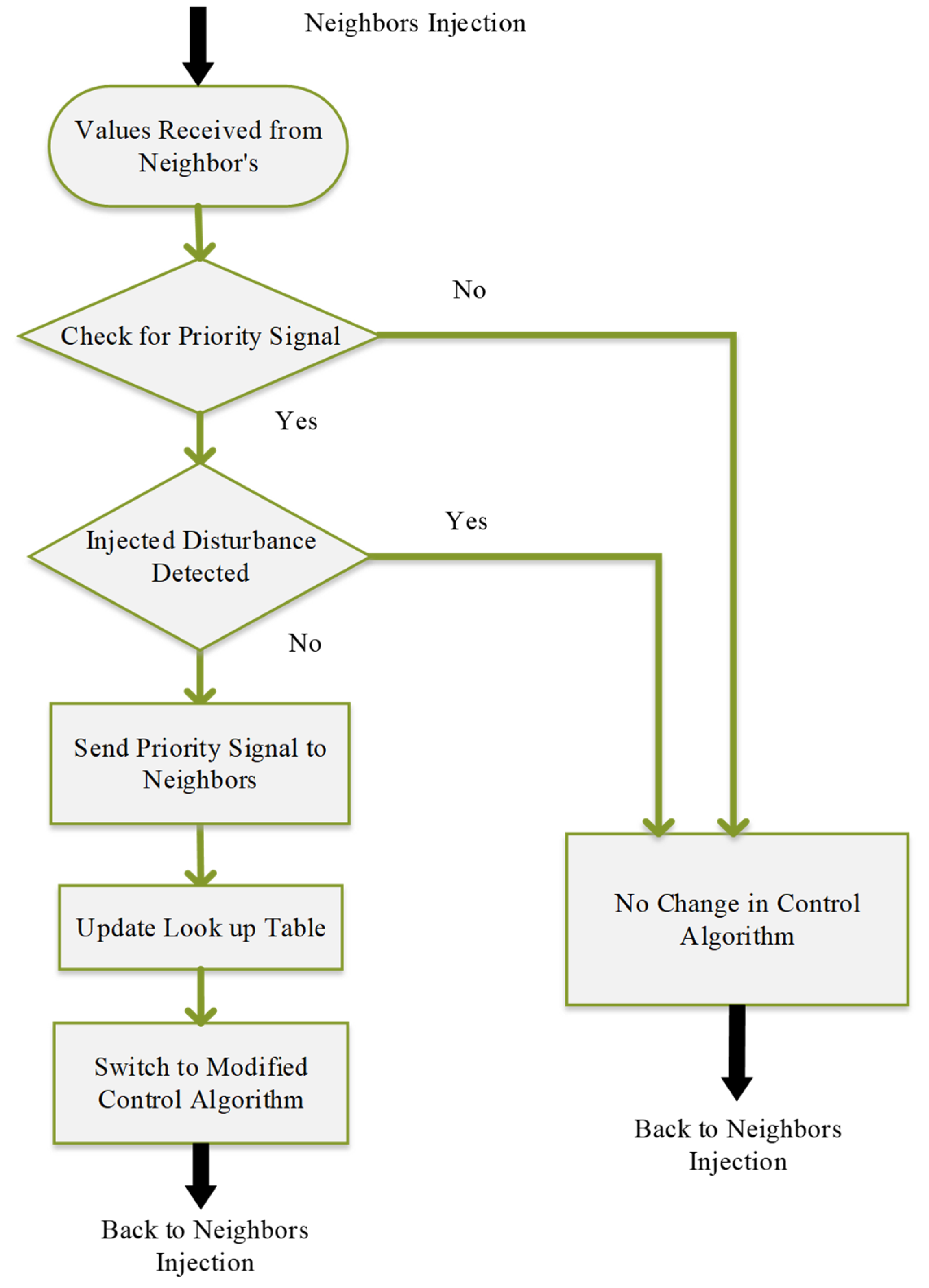
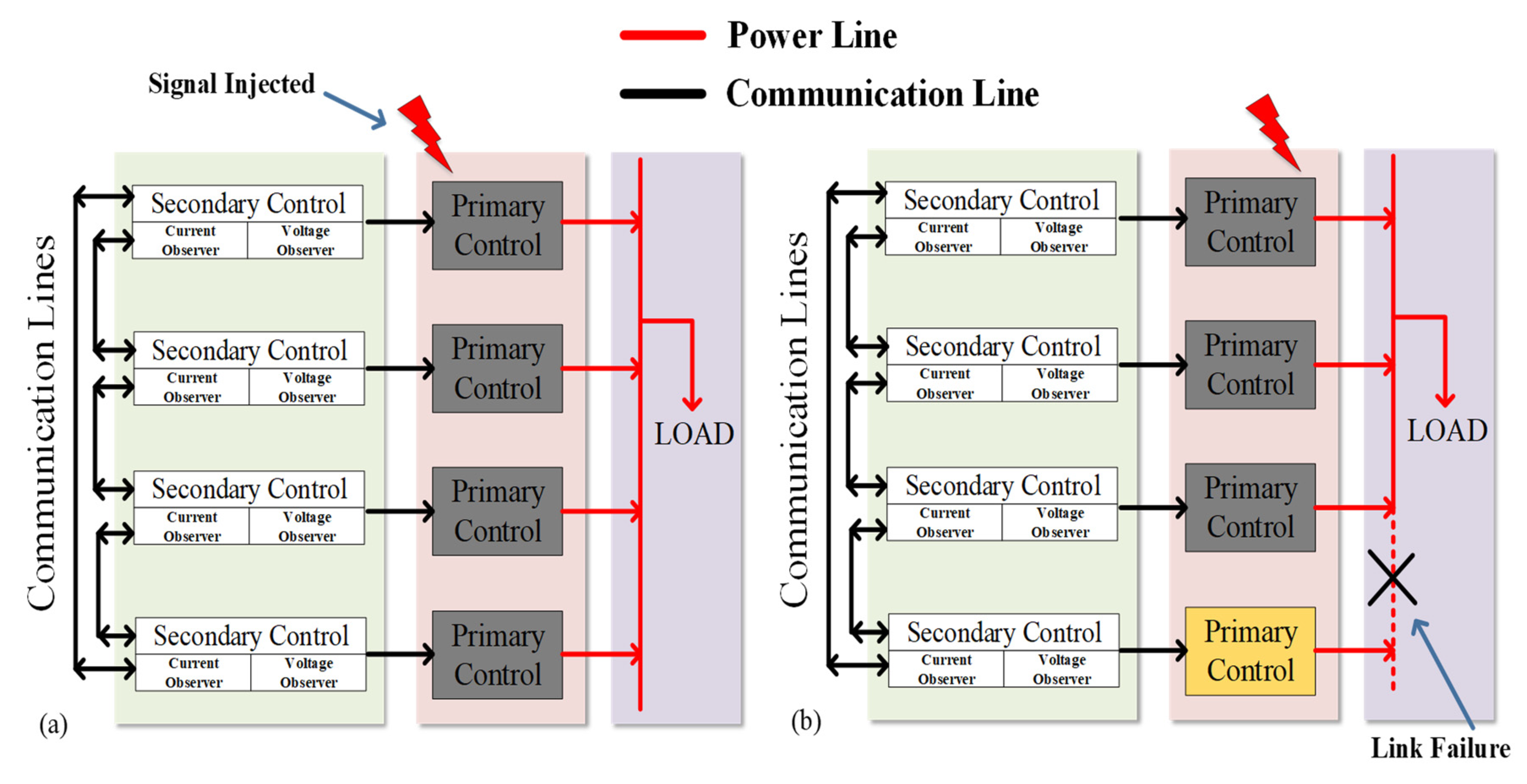
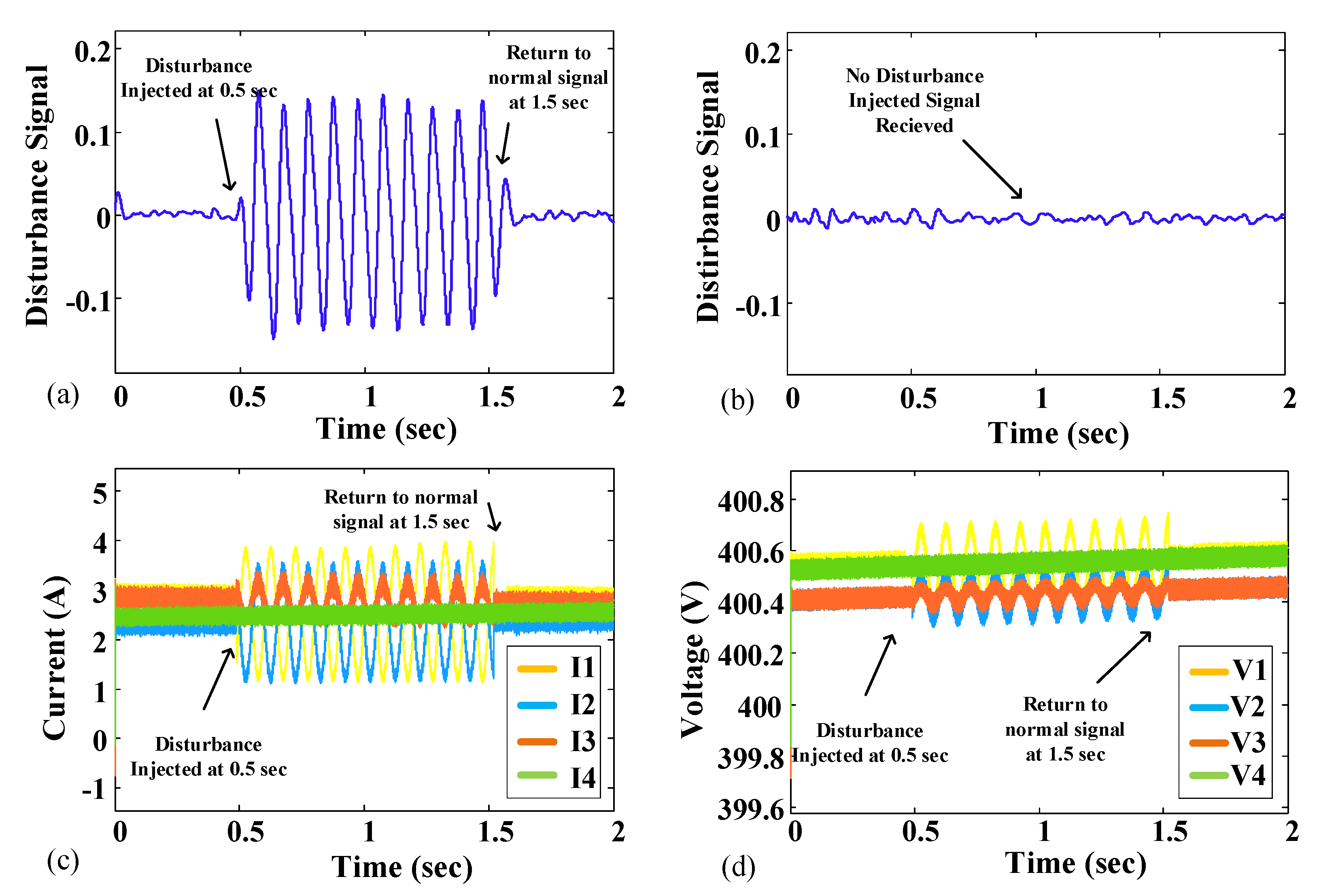
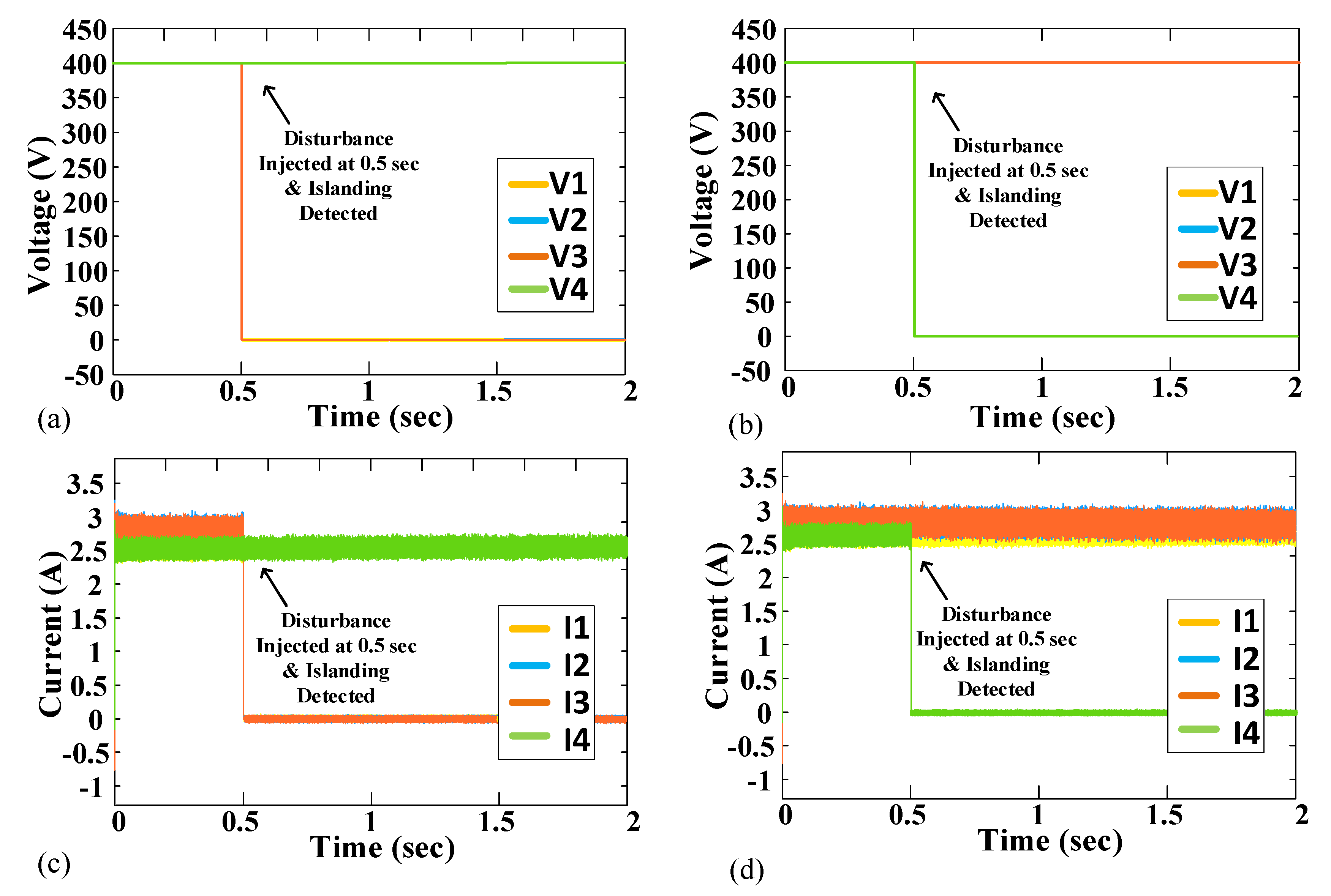
| Local Islanding Detection Schemes | List of Detection Methods |
|---|---|
| Passive Detection Method | Under/Over Voltage |
| Voltage Harmonics | |
| Voltage Unbalance | |
| Voltage Phase Shift | |
| Under/Over Frequency | |
| Total Harmonic Distortion | |
| Active Detection Method | Impedance Measurement |
| Load Fluctuation | |
| Disturbance Signal Injection | |
| Reactive Power Fluctuation | |
| Frequency Bias | |
| Frequency Shift | |
| Voltage Shift |
| Remote Detection Method | List of Detection Techniques |
| SCADA System | |
| PLC (Power Line Carrier) | |
| Phasor Measurement Unit (PMU) | |
| Disconnect Signal |
| Parameters | Values |
|---|---|
| Input (Vin) | 600 V |
| Output (Vo) | 400 V |
| G Droop | 0.025 |
| L | 1 mH |
| C | 300 µF |
| Load (R) | 70 ohm |
| RLine | 0.0005 ohm/m |
| LLine | 0.50 µH/m |
| Line Length | 100 m |
| fSwitching | 10 kHz |
| Communication Delay | 0.15 ms |
| Gain Inner loop | Kp = 10 |
| Ki = 0.05 | |
| Gain Outer loop | Kp = 40 |
| Ki = 0.05 | |
| V Observer | Kp = 6 |
| Ki = 0.1 | |
| I Observer | Kp = 0.11 |
| Ki = 0.6 |
| Nodes | N1 | N2 | N3 | N4 |
|---|---|---|---|---|
| N1 | 0 | 1 | 0 | 1  0 0 |
| N2 | 1 | 0 | 1 | 0 |
| N3 | 0 | 1 | 0 | 1  0 0 |
| N4 | 1  0 0 | 0 | 1  0 0 | 0 |
 0 shows the dis-connectivity of the nodes.
0 shows the dis-connectivity of the nodes.| Sr. No. | Parameters | Passive | Active | Remote | Proposed Method |
|---|---|---|---|---|---|
| 1 | Principle Operation | Observe and Measure the change in voltage, frequency, and Harmonics | Inject disturbance signal to observe the system response | Communication signals exchange between Power system components. | Communication signals exchange between Connected Nodes |
| 2 | Operating Time | Short Interval | Long Interval | Short Interval | Short Interval |
| 3 | Non-Detection Zone (NDZ) | Large Range | Small Range | No | No |
| 4 | Effect of the Distribution System | No | Yes | No | No |
| 5 | Cost Affective | Low | High | High | No Extra Cost for Implementation of Control |
Publisher’s Note: MDPI stays neutral with regard to jurisdictional claims in published maps and institutional affiliations. |
© 2021 by the authors. Licensee MDPI, Basel, Switzerland. This article is an open access article distributed under the terms and conditions of the Creative Commons Attribution (CC BY) license (https://creativecommons.org/licenses/by/4.0/).
Share and Cite
Shahid, M.U.; Alquthami, T.; Siddique, A.; Munir, H.M.; Abbas, S.; Abbas, Z. RES Based Islanded DC Microgrid with Enhanced Electrical Network Islanding Detection. Energies 2021, 14, 8432. https://doi.org/10.3390/en14248432
Shahid MU, Alquthami T, Siddique A, Munir HM, Abbas S, Abbas Z. RES Based Islanded DC Microgrid with Enhanced Electrical Network Islanding Detection. Energies. 2021; 14(24):8432. https://doi.org/10.3390/en14248432
Chicago/Turabian StyleShahid, Muhammad Umair, Thamer Alquthami, Abubakar Siddique, Hafiz Mudassir Munir, Saqlain Abbas, and Zulkarnain Abbas. 2021. "RES Based Islanded DC Microgrid with Enhanced Electrical Network Islanding Detection" Energies 14, no. 24: 8432. https://doi.org/10.3390/en14248432
APA StyleShahid, M. U., Alquthami, T., Siddique, A., Munir, H. M., Abbas, S., & Abbas, Z. (2021). RES Based Islanded DC Microgrid with Enhanced Electrical Network Islanding Detection. Energies, 14(24), 8432. https://doi.org/10.3390/en14248432







